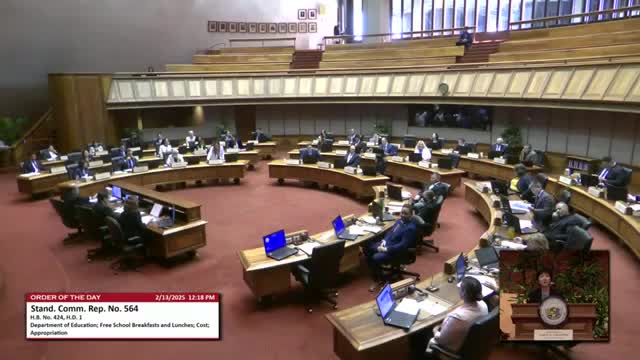House members urge support for covering reduced-price school meals, arguing hunger impedes learning
February 13, 2025 | House of Representatives, Legislative , Hawaii
This article was created by AI summarizing key points discussed. AI makes mistakes, so for full details and context, please refer to the video of the full meeting. Please report any errors so we can fix them. Report an error »

Members of the Hawaii House of Representatives used floor debate while committee reports were considered to press for a measure to cover reduced-price school meals for eligible students.
“Free and reduced lunch — a family of four needs to be making $47,000 for free lunch,” Representative Lehi said while urging support, adding that students often arrive hungry and cannot learn without reliable nutrition. Representative Capela argued on the House floor that the issue is straightforward: “No child should be hungry and no child can learn if they are hungry.”
Another member explained the dollar-and-cents mechanics of the reduced-price program on the floor: for an individual student the reduced-price subsidy equals 30¢ for breakfast and 40¢ for lunch, meaning the legislature would pay 70¢ per day for each qualifying student should the measure pass.
Speakers framed the discussion around classroom readiness and student welfare. Representative Lehi described testimony the education committee heard from students and teachers about hungry children and teachers who have had to share food with students or report accounts that cannot be replenished by parents. Representative Litchi (floor procedure interruption) and others reiterated that the bill aims to remove a barrier to learning, not to replace existing free-meal provisions.
The comments occurred while members were considering a package of standing committee reports (nos. 533–631); the transcript does not specify the individual bill number on the floor during these remarks. The House did not hold a separate recorded roll-call vote on the specific school-meal subsidy in the excerpted transcript; the overall package was adopted by voice vote.
Why it matters
Advocates and multiple legislators told colleagues that feeding students is directly tied to educational outcomes. If the legislature funds reduced-price meals, eligible students could have out-of-pocket meal charges covered at a capped per-day rate; proponents said the per-student cost is small compared with the potential classroom benefits.
What was not decided
The transcripted floor action did not include an individual vote on a discrete bill number for the reduced-price subsidy; the discussion took place during broader consideration of standing committee reports. Budget sources, long-term funding commitments, and implementation details (for example, whether the payment would be state-funded or offset by other sources) were not specified on the floor.
Speakers and sourcing
Quotes and floor remarks in this article are attributed to members present on the House floor during the discussion. The transcript records floor statements of support but does not show a discrete final vote on this particular subsidy in the provided excerpt.
“Free and reduced lunch — a family of four needs to be making $47,000 for free lunch,” Representative Lehi said while urging support, adding that students often arrive hungry and cannot learn without reliable nutrition. Representative Capela argued on the House floor that the issue is straightforward: “No child should be hungry and no child can learn if they are hungry.”
Another member explained the dollar-and-cents mechanics of the reduced-price program on the floor: for an individual student the reduced-price subsidy equals 30¢ for breakfast and 40¢ for lunch, meaning the legislature would pay 70¢ per day for each qualifying student should the measure pass.
Speakers framed the discussion around classroom readiness and student welfare. Representative Lehi described testimony the education committee heard from students and teachers about hungry children and teachers who have had to share food with students or report accounts that cannot be replenished by parents. Representative Litchi (floor procedure interruption) and others reiterated that the bill aims to remove a barrier to learning, not to replace existing free-meal provisions.
The comments occurred while members were considering a package of standing committee reports (nos. 533–631); the transcript does not specify the individual bill number on the floor during these remarks. The House did not hold a separate recorded roll-call vote on the specific school-meal subsidy in the excerpted transcript; the overall package was adopted by voice vote.
Why it matters
Advocates and multiple legislators told colleagues that feeding students is directly tied to educational outcomes. If the legislature funds reduced-price meals, eligible students could have out-of-pocket meal charges covered at a capped per-day rate; proponents said the per-student cost is small compared with the potential classroom benefits.
What was not decided
The transcripted floor action did not include an individual vote on a discrete bill number for the reduced-price subsidy; the discussion took place during broader consideration of standing committee reports. Budget sources, long-term funding commitments, and implementation details (for example, whether the payment would be state-funded or offset by other sources) were not specified on the floor.
Speakers and sourcing
Quotes and floor remarks in this article are attributed to members present on the House floor during the discussion. The transcript records floor statements of support but does not show a discrete final vote on this particular subsidy in the provided excerpt.
View full meeting
This article is based on a recent meeting—watch the full video and explore the complete transcript for deeper insights into the discussion.
View full meeting
